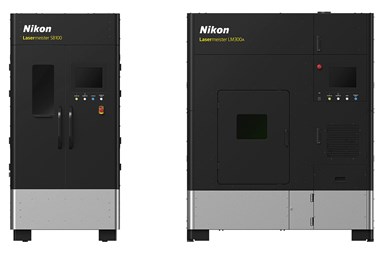Nikon Metal DED 3D Printer Optimized for Industrial Applications
This technology gives manufacturers the ability to build onto existing parts with high precision and utilize a variety of materials, reducing lead times and minimizing postprocessing requirements.
Share




Nikon Corp.’s latest metal additive manufacturing (AM) system includes the Lasermeister LM300A, which uses directed energy deposition (DED) technology, as well as the complementary 3D scanner, Lasermeister SB100. While the system’s predecessor, the Lasermeister 100A metal AM system series, is well suited for research purposes, the company says this latest solution was specially developed for industrial applications.
Building upon the processing capabilities of the previous systems, the LM300A supports an expanded build area and is also equipped with the newly developed 3D scanner, the SB100. This 3D scanner supports factory automation by enabling users to scan each workpiece with the click of a button and then automatically generates the toolpath data for the 3D printing process to begin.
To address the challenges in the conventional repair process, Nikon developed the LM300A and SB100 as a solution that can reduce lead times up to 65% compared to the conventional welding process and minimize postprocessing requirements. This technology can provide value to automobile, railway, machinery industry, turbine blade and other repair applications.
The system is said to offer seamless scanning and toolpath generation. By placing a workpiece, such as a worn-out blade, inside the SB100, with a click of a button, the module begins to scan and measure the workpiece inside the chamber. It then compares its current actual shape with the CAD model to extract the difference, using a built-in, high-precision scanning feature. The SB100 then automatically generates the toolpath data for repair specific to each damaged or worn-out workpiece.
This entire process is easily completed and does not require any special skills or manual cutting of the repair area. The toolpath data is then transferred to the LM300A to initiate high-precision additive manufacturing. Once the additive process is completed, the workpiece can be placed back into the SB100, where it will scan and inspect to confirm the repair was performed to match the model. This automation and streamlined workflow can lead to reduced costs and lead time for industrial users.
The system also offers high-precision processing for various metal materials. The LM300A performs high-precision processing by leveraging advanced optical and precision control technology developed across decades of Nikon semiconductor lithography systems.
Related Content
-
The Benefits of Vertically Integrating Metal 3D Printing and Machining
Having 3D printing and machining within one organization enables Addman’s engineers to collaborate and consolidate so it can quickly make successful metal 3D printed parts.
-
6 Trends in Additive Manufacturing Technology
IMTS 2024 features a larger Additive Manufacturing Pavilion than ever before, with veteran suppliers alongside startups and newcomers at the front of the West Building. As you browse these exhibitors, as well as booths found elsewhere at the show, keep an eye out for these trends in AM.
-
Chuck Jaws Achieve 77% Weight Reduction Through 3D Printing
Alpha Precision Group (APG) has developed an innovative workholding design for faster spindle speeds through sinter-based additive manufacturing.


























